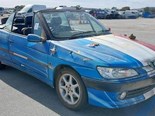Farmer's Fargo - Blackbourn
 Quarter- windows are for parcel-shelf passengers
Quarter- windows are for parcel-shelf passengers


|
|
Quarter- windows are for parcel-shelf passengers
|
Not the Fargo in North Dakota, a Fargo in North Queensland
A pair of those little coincidences that punctuate life popped up recently for me wearing Fargo labels. A conversation about clever movies had me praising the Coen brothers. I focused particularly on Frances McDormand’s beguiling performance as Brainerd, Minnesota’s heavily pregnant Chief of Police, Marge Gunderson in Fargo.
The next day an article in Restored Cars Australia magazine about the gradual disappearance of parcel shelves from Australian-built utes included a three-quarter-tonne Fargo in its case study. This was the first mention of Fargo vehicles I’ve struck in years.
Older readers will know Fargo as a Chrysler Corporation truck brand. It ran for around 50 years following Chrysler’s purchase of the Chicago-based Fargo Motor Company in 1928 (so against the odds there’s no obvious connection between Fargo trucks and North Dakota’s city of the same name). For many years Chrysler Canada produced virtually identical Dodge and Fargo trucks, badge-engineered to give Chrysler/Plymouth car dealers a Fargo commercial range to compete with Dodge car dealers stocking Dodge commercials.
Chrysler Australia took a leaf out of the rebadging book in marketing its product range. In the early-1950s the sorely underfunded local outfit offered three subtly differentiated Oz versions of a 1954 American Plymouth four-door sedan wearing Plymouth, Dodge, and De Soto badges – all powered by Chrysler’s gutsy and reliable flathead six.

The coupe-utility variant came in the same three flavours. The three four-door sedan versions continued until May 1957 when all three were replaced by the locally developed AP1 Chrysler Royal. While the AP1’s passenger-compartment body section and its basic underpinnings still borrowed heavily from the 1954 Plymouth, it received all-new front and rear sheetmetal and a V8 engine option was offered alongside the trusty flathead six. During the same period Chrysler’s larger ¾-tonne pick-ups, grandaddies of today’s RAMs, wore either Dodge or Fargo branding here.
My Fargo connection came during a student-days summer job working on a tobacco farm on North Queensland’s Atherton Tableland. The farm truck was a ¾-tonne Fargo, a well-used and battle-scarred workhorse that willingly performed everything asked of it. Being a resourceful bloke, Jack the farmer had swapped out its original high-mileage six for a later 230-cube flathead six from a written-off Chrysler Royal.
Its healthy 87kW (117hp) made the old Fargo a surprisingly willing goer for the time – not exactly doing RAM numbers, but lively nevertheless. Chrysler’s flatheads benefited from an updated version of Ricardo’s ‘turbulent’ combustion-chamber design that made the most of a flathead’s inherent low-compression ratio by maximising the ‘squish’ effect. The 230-cube Chrysler Six outperformed the 239-cube Ford V8 flathead that had powered 1952-54 Customlines and Mainlines.
Jack had no trouble locating a bent Royal locally for the engine swap – numerous cars (and occupants) came to grief on the notorious single-lane strip of bitumen then linking Mareeba with Dimbulah. Crashes resulting from neither of the pig-headed drivers of oncoming vehicles being willing to back off and move off the tar was a common scenario.

Chrysler’s unkillable six
My mate Andy and I always got the keys to the Fargo for our weekly day off and if Jack had business to do in Mareeba we would deposit him there on our way down to Cairns or wherever. Mostly he scored a lift home with mates. One time however the day got away from him, as did the length of an afternoon session with his mates. Ever resourceful, Jack correctly assumed Andy and I would be at Masterson’s Hotel celebrating the end of a good day out before heading home.
Reconnecting with my earlier mention of parcel shelves in Australian-built utes – the old Fargo’s parcel shelf was generous to a fault, sufficiently generous that when we jumped back in the ute after closing time we found Jack sound asleep on it. He slept like a baby all the way home.
Jack was a practical man more than a perfectionist, as I learned after enquiring about the three-inch (75mm) hardwood block apparently supporting the front of the Fargo’s engine. He explained that it overcame the height mismatch between the front mounts on the original and replacement engines. That was true as far as it went, and impressively it had stayed in place doing the job reliably for a couple of years, including on a punishing trip Andy and I did on the then rough-as-guts Mulligan ‘highway’ to Cooktown that broke a rear spring leaf.
From Unique Cars #478, May 2023
Unique Cars magazine Value Guides
Sell your car for free right here
Get your monthly fix of news, reviews and stories on the greatest cars and minds in the automotive world.
Subscribe

.jpg)









.jpg)



